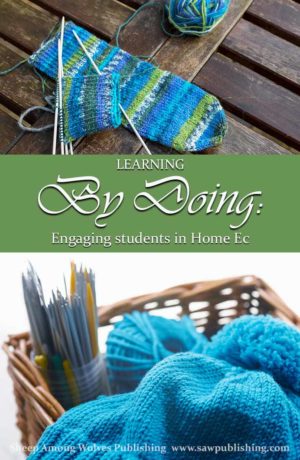Learning by Doing: Engaging Students in Home Ec
 Do you struggle with engaging students in home ec?
Do you struggle with engaging students in home ec?
I was probably about seven or eight when I had my first un-engaging experience with home ec. Our homeschooling group had decided to start a learn-to-knit project. Every student who wanted to join was started on the classic first knitting project—the venerable knitted scarf. Venerable, alas! in two sense of the word. That thing never ended! It went on—and on—and on! There was no getting to the end of it. There was no getting to even the middle of it.
I was certainly learning a valuable life-skill. But my interest was completely un-engaged.
Today’s Timeless Tip comes to us from Ellen Claydon and C. P. Claydon, co-authors of the early 20th Century textbooks Knitting Without “Specimens” and Needlework Without “Specimens.” While these manuals focus specifically on handwork, their principles can be applied to all forms of home ec—and in fact, to the whole of our grade school curriculum.
Learning by Doing: Engaging Students in Home Ec
Claydon and Claydon wrote into an educational world where the philosophy of “specimen” or drill work was widely embraced. “Specimens” were essentially stitch samples—pieces of knitting, crocheting, or needlework created to demonstrate a student’s understanding of a certain skill. They were worked purely for practice and—like my endless scarf—they were highly un-motivating to the students themselves.
“Pounds of wool and knitting cotton have been wasted in this manner, to serve no useful end. Worse still, the lack of purpose in the work served to kill the child’s interest instead of stimulating it.” — Knitting Without “Specimens”
The Claydons believed that it was possible for students to “learn all varieties of stitches while making useful articles and garments.” This concept of teaching handwork without repetitive drill, forms the foundation of their textbooks.
 Learning Through Achievable Projects
Learning Through Achievable Projects
Now, obviously, my unfortunate scarf was—from a technical perspective—the essence of a useful project. If memory serves, the variegated blue-and-orange yarn even went nicely with my burnt-orange ski jacket. The intention was that I would have a useful article of clothing when the project was finished. The trouble was, the size of the project was so intimidating that I lost faith in my own ability to complete it. Once that happened, the useful scarf had, in reality, turned into a “specimen.”
One of the Claydons’ foundational principles was that home ec projects such as knitting or sewing needed to be short enough to feel achievable to the student. “A remote end does not appeal to a little child,” they argued. For a six or seven-year-old, “achievable” meant a very tiny project. Their knitting manual opens with such projects as a doll’s muff, a toy purse, and a pincushion cover. The entire first grade of their needlework textbook is limited to projects made out of squares and rectangles—without a single finished piece measuring more than a square foot.
For other aspects of home ec, might we suggest that jam sandwiches and frozen lemonade and bananas sliced with a butter knife have a place in a primary school curriculum? Start small. Start very small. Baby steps are a cornerstone of engaging your students in home ec.
Gaining the Confidence of Experience
Skill is something that can be attain at any age in life. I really believe that. But the confidence of being completely at home in a subject—the confidence of real experience—is something that is overwhelmingly easier to obtain if you start young.
“. . . Girls who learn to cut out and make actual articles and garments from the time they first begin needlework, will always feel at home with the subject, and have an aptitude for cutting and sewing which no subsequent amount of adult training could ever give them.” — Needlework without “Specimens”
As I have discussed previously (see the link at the bottom of this post) I believe that home ec should be part of early childhood education. If our students are old enough to learn the basics of literacy they are old enough to learn the basics of homemaking, too. Children who learn these basics at a young age will be comfortable and confident in the field of home economics all their life. But if we are going to embrace this philosophy, we will need to do it in a way that succeeds in engaging students in home ec.
Teaching for Real Life
I didn’t get to the end of the endless scarf. Sometime—long after my motivation had evaporated—I decided to take the hapless rectangle off the needles. I ran a single strand of yarn through all the loops to keep them from unravelling and used the resulting strip as a blanket for my doll.
Many years (and at least one more started-and-failed scarf attempt) later, I actually did learn to knit, and to enjoy knitting. Incidentally, my first independent project was a doll’s sweater.
Whether or not you are including knitting in your home ec course—whether your students are in the first grade or the twelfth—Ellen and C. P. Claydon’s educational philosophy of useful projects, achievable assignments, and the confidence that comes from experience, holds a precious key for unlocking the mystery of successful teaching and engaging students in home ec.
Are you interested in a further discussion of home ec as a primary and elementary school subject? See our previous post:

How can we teach our daughters to be godly, virtuous women? Timeless Tip #8 uses handwork as a powerful tool to educate children in the virtue of diligence.

Timeless Tips from Homemakers of the Past is a great place to find encouragement as a keeper at home.

At SAW Publishing we are passionate about promoting good and great books. But just what do we mean by that term? Exactly why does SAW Publishing exist?

